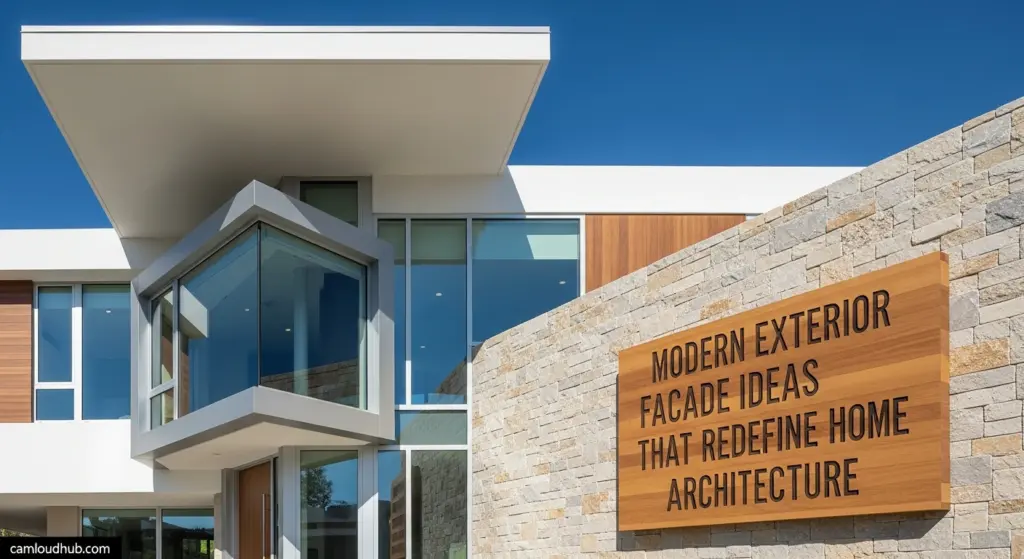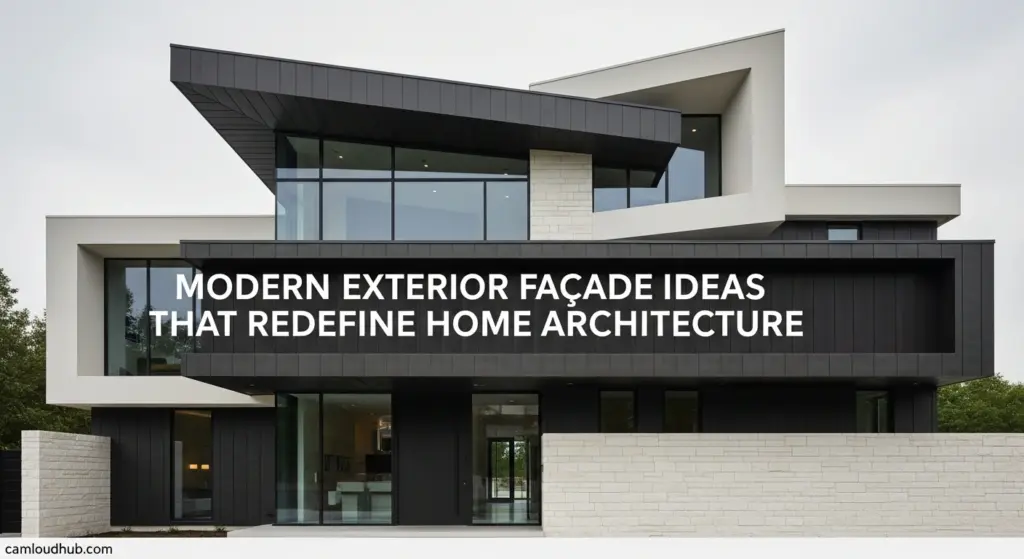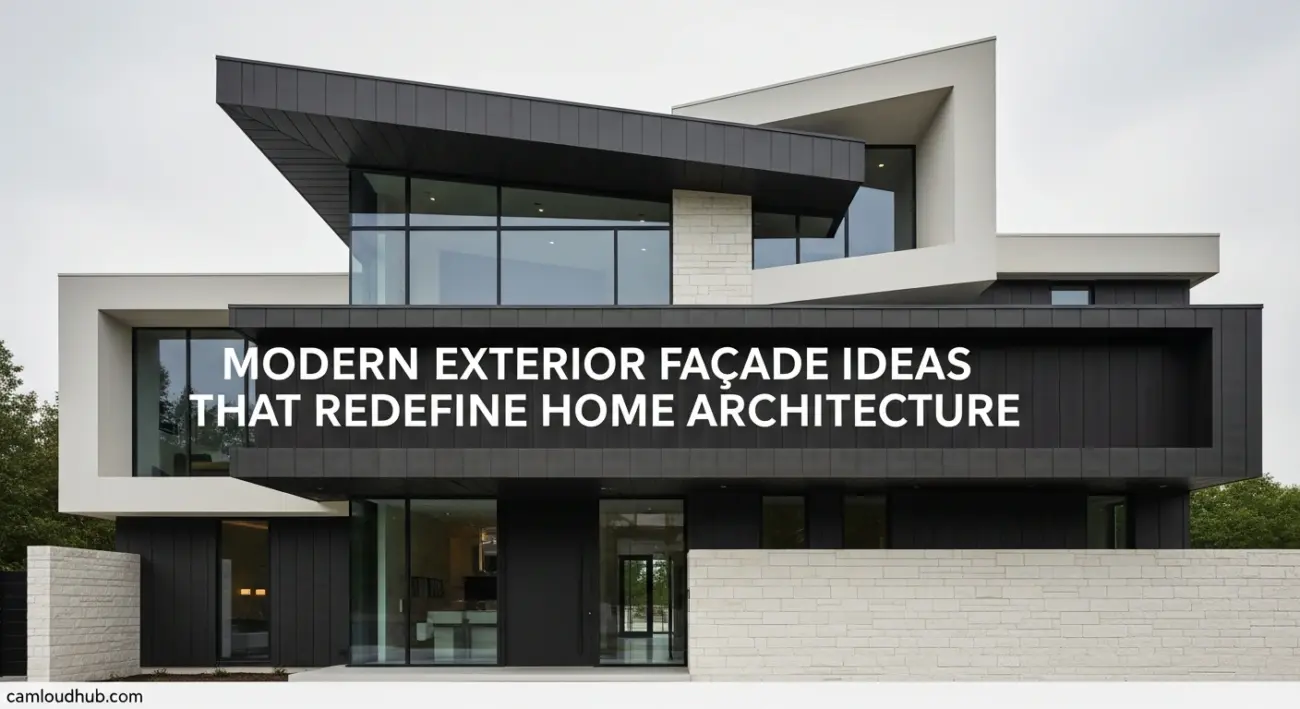Understanding the Essence of Modern Exterior Facades
Modern Exterior Facade Ideas That Redefine Home Architecture – A modern exterior facade is not just about aesthetics; it’s about creating a cohesive and integrated design that blends seamlessly with the environment while reflecting the personality of the homeowner. Understanding the core principles of modern design is crucial to selecting the right facade elements. This involves embracing minimalism, clean lines, geometric shapes, and a focus on functionality. Understanding the key principles allows effective implementation of modern exterior facade ideas.
Material Innovation in Modern Facades
One of the defining characteristics of modern exterior facades is the innovative use of materials. Traditional materials like brick and wood are being reinterpreted in new and exciting ways, while innovative materials like metal, concrete, glass, and composite materials are taking center stage. The selection of materials should consider factors such as durability, weather resistance, aesthetics, and sustainability.

- Metal Cladding: Metal cladding offers a sleek and contemporary look with excellent durability and weather resistance. Options include aluminum, steel, zinc, and copper, each with its unique texture and visual appeal. Metal can be used to create striking geometric patterns, providing a distinctive look.
- Concrete Panels: Precast concrete panels provide a modern, industrial aesthetic with exceptional strength and longevity. They can be customized with different colors, textures, and finishes, allowing for creative design possibilities. Concrete is also a relatively sustainable option compared to other materials.
- Glass Facades: Glass facades bring transparency and natural light into the home, creating a seamless connection with the surrounding environment. Large expanses of glass can be incorporated into the facade, providing stunning views and a sense of openness. It is often used with shading systems to address solar heat gain.
- Wood Cladding: Wood adds warmth and natural beauty to modern facades. Sustainable wood species like cedar, redwood, and cypress are excellent choices for exterior cladding. Wood can be used in horizontal or vertical applications, with different profiles and finishes to create unique textures.
- Composite Materials: Composite materials like fiber cement and wood-plastic composites offer the look and feel of natural materials with improved durability and low maintenance requirements. These materials are resistant to rot, insects, and fire, making them ideal for exterior applications.
The Role of Texture and Color in Facade Design
Texture and color play crucial roles in shaping the overall aesthetic of a modern exterior facade. Texture can add depth and visual interest, while color can evoke emotions and create a desired mood. The combination of texture and color should be carefully considered to achieve the desired visual impact.
- Textural Variations: Introduce texture using different materials or by creating patterns within the same material. Corrugated metal, textured concrete, and wood siding with varying profiles can add visual interest.
- Color Palette: A carefully chosen color palette can enhance the architectural features of the home and complement the surrounding landscape. Neutral colors like gray, white, and black are commonly used in modern facades, often accented with pops of color.
- Contrast and Harmony: Create contrast by combining different materials or colors, or achieve harmony by using similar tones and textures. The choice depends on the desired aesthetic effect.
Integrating Sustainability into Facade Design
Sustainable design is an integral part of modern architecture. Facades can be designed to reduce energy consumption, improve indoor air quality, and minimize environmental impact. Aspects to consider include material selection, insulation, shading strategies, and rainwater harvesting. Selecting materials responsibly and implementing modern exterior facade ideas can drastically improve the sustainability of your property.
- Energy Efficiency: Use high-performance insulation materials to reduce heat loss and gain. Install energy-efficient windows and doors. Incorporate solar shading devices to minimize solar heat gain.
- Material Selection: Choose sustainable and locally sourced materials with low embodied energy. Use recycled or reclaimed materials whenever possible.
- Green Walls: Integrate vertical green walls into the facade to improve air quality, reduce urban heat island effect, and add visual appeal.
- Water Management: Design the facade to collect and reuse rainwater for irrigation or other non-potable uses.

Exquisite Modern Exterior Facade Ideas
Exploring various design approaches allows you to tailor the facade to your specific taste and architectural style. Here are some diverse ideas to consider:
Minimalist Facades: Simplicity and Elegance
Minimalist facades embrace simplicity and clean lines, focusing on essential elements. These facades often feature a limited color palette, smooth surfaces, and geometric shapes. The emphasis is on creating a timeless and understated design.
- Clean Lines and Geometric Forms: Use simple geometric shapes like squares, rectangles, and triangles to create a clean and modern look. Avoid overly detailed or ornamental elements.
- Monochromatic Color Palette: Stick to a limited color palette, often using shades of white, gray, or black. This creates a sense of visual harmony and simplicity.
- Large Windows and Open Spaces: Incorporate large windows and open spaces to maximize natural light and create a seamless connection with the surrounding environment.
- Hidden Gutters and Downspouts: Conceal gutters and downspouts to maintain the clean lines of the facade.
- Integrated Lighting: Install recessed or minimalist lighting fixtures to accentuate the architectural features of the facade without adding visual clutter.
Dynamic Facades: Movement and Transformation
Dynamic facades incorporate elements that move or change over time, creating a sense of dynamism and visual interest. These facades can be designed to respond to changing weather conditions, optimize energy performance, or simply provide a unique aesthetic element.
- Kinetic Architecture: Incorporate moving panels, louvers, or screens that adjust in response to sunlight, wind, or other environmental factors.
- Interactive Lighting: Use programmable LED lighting to create dynamic displays or patterns on the facade.
- Living Walls with Seasonal Changes: Design living walls that change color and texture throughout the year, adding a dynamic and natural element to the facade.
- Water Features: Incorporate water features like waterfalls or fountains that add movement and sound to the facade.
- Projection Mapping: Use projection mapping to project dynamic images or animations onto the facade, creating a visually stunning effect.
Biophilic Facades: Connecting with Nature
Biophilic facades integrate natural elements into the design, fostering a connection with nature and promoting well-being. These facades often incorporate green walls, natural materials, and biomorphic forms.
- Vertical Gardens: Install vertical gardens or green walls to bring nature closer to the building and improve air quality.
- Natural Materials: Use natural materials like wood, stone, and bamboo to create a warm and inviting facade.
- Biomorphic Forms: Incorporate organic shapes and patterns inspired by nature to create a visually appealing and harmonious design.
- Daylight Optimization: Design the facade to maximize natural daylight and reduce the need for artificial lighting.
- Nature-Inspired Color Palette: Use a color palette inspired by nature, with shades of green, brown, and blue, to create a calming and restorative environment.
High-Tech Facades: Embracing Innovation
High-tech facades incorporate advanced technologies to enhance the performance, aesthetics, and functionality of the building. These facades may feature smart glass, solar panels, integrated sensors, and automated control systems.
- Smart Glass: Use smart glass that can change its transparency in response to sunlight, reducing glare and heat gain.
- Integrated Solar Panels: Incorporate solar panels into the facade to generate renewable energy and reduce carbon footprint.
- Automated Shading Systems: Install automated shading systems that adjust based on weather conditions and building occupancy.
- Building Integrated Photovoltaics (BIPV): Integrate solar cells directly into the building materials of the facade.
- Smart Sensors: Use sensors to monitor environmental conditions and adjust building systems accordingly, optimizing energy performance and indoor comfort.
The Play of Light and Shadow in Modern Facade Design
Employing light and shadow techniques can dramatically enhance the visual appeal of a building’s façade. It’s not just about the materials used but how light interacts with them. Manipulating light is essential to create depth and visual interest in modern exterior facade ideas.
Louvers and Screens: Controlling Sunlight and Privacy
Louvers and screens are architectural elements used to control sunlight and privacy while adding a touch of style to the facade. These can be made from a variety of materials, including wood, metal, and composite materials.
- Horizontal Louvers: These are typically installed horizontally and can be adjusted to control the amount of sunlight entering the building.
- Vertical Louvers: Vertical louvers offer a different aesthetic and can be particularly effective in controlling sunlight from the east and west.
- Decorative Screens: Screens can be used to create intricate patterns and add a decorative element to the facade while providing privacy and shading.
- Automated Louvers: These systems automatically adjust the angle of the louvers based on the position of the sun, optimizing energy performance.
Green Facades and Living Walls: Bringing Nature to Urban Spaces
Green facades and living walls are innovative ways to incorporate greenery into the exterior of a building, offering numerous environmental and aesthetic benefits.
- Vertical Gardens: These are self-sufficient ecosystems that can be installed on the exterior walls of a building, providing insulation, improving air quality, and enhancing biodiversity.
- Climbing Plants: Training climbing plants to grow on the facade can create a lush and natural look while protecting the building from the elements.
- Modular Green Walls: These prefabricated systems are easy to install and maintain, offering a flexible solution for creating green facades.
- Hydroponic Systems: Hydroponic systems can be used to grow plants without soil, making them ideal for vertical green walls in urban environments.
Integrating Balconies and Outdoor Spaces into the Facade Design
Incorporating balconies and outdoor spaces into the facade design can enhance the functionality and appeal of a building, creating seamless transitions between indoor and outdoor living.
- Cantilevered Balconies: These balconies extend outward from the building, offering unobstructed views and creating a sense of spaciousness.
- Recessed Balconies: Recessed balconies provide more privacy and shelter from the elements, creating a cozy outdoor retreat.
- Green Balconies: Adding greenery to balconies can create a more inviting and natural atmosphere, blurring the lines between indoor and outdoor spaces. Implementing this with modern exterior facade ideas helps create a wonderful natural aesthetic.
- Glass Railings: Glass railings offer a modern and minimalist look while maximizing views and natural light.
Navigating the Challenges of Modern Facade Design
Addressing common challenges and potential issues ensures a successful facade design that balances aesthetics, functionality, and durability.
Climate Considerations for Facade Materials
Different climates require different facade materials and design strategies. Understanding the specific challenges of a particular climate is crucial for selecting the right materials and ensuring long-term performance.
- Hot and Arid Climates: Choose materials that reflect sunlight and provide insulation to reduce heat gain. Consider incorporating shading devices and evaporative cooling systems.
- Cold Climates: Use high-performance insulation materials to minimize heat loss. Select materials that are resistant to freeze-thaw cycles.
- Humid Climates: Choose materials that are resistant to moisture and mold growth. Provide adequate ventilation to prevent condensation.
- Coastal Climates: Select materials that are resistant to salt and corrosion. Use durable coatings and finishes to protect against the harsh marine environment.
Addressing Energy Efficiency and Thermal Performance
Facades play a crucial role in determining the energy efficiency and thermal performance of a building. Designing a facade that minimizes heat loss and gain can significantly reduce energy consumption and improve indoor comfort.
- Insulation: Use high-performance insulation materials to reduce heat loss and gain. Properly insulate walls, roofs, and windows.
- Thermal Bridging: Minimize thermal bridging by using continuous insulation and thermally broken components. Addressing this minimizes the inefficiency of modern exterior facade ideas allowing for maximum thermal performance.
- Air Sealing: Seal all gaps and cracks in the facade to prevent air leakage. This reduces energy consumption and improves indoor air quality.
- Window Performance: Use energy-efficient windows with low-E coatings and insulated frames. Properly seal windows to prevent air leakage.
Cost-Effective Modern Facade Solutions
Achieving a modern facade design doesn’t have to break the bank. There are many cost-effective solutions that can create a stunning and functional facade without exceeding budget.
- Material Selection: Choose affordable and readily available materials. Consider using reclaimed or recycled materials.
- Simple Design: Opt for a simple and minimalist design that minimizes material waste and labor costs.
- Prefabrication: Use prefabricated facade components to reduce on-site construction time and labor costs.
- Phased Construction: Break the project into phases, allowing for a more manageable budget and timeline.
- Value Engineering: Look for opportunities to reduce costs without compromising quality or performance.
Integrating Technology into Modern Facade Design
Technology integration can enhance the performance, aesthetics, and functionality of modern exterior facades, ensuring responsiveness and sustainability.
Smart Building Integration for Facades
Smart building technologies can be integrated into the facade to optimize energy efficiency, improve indoor comfort, and enhance security.
- Automated Lighting Control: Use sensors and timers to control lighting levels throughout the day, reducing energy consumption.
- Smart Window Systems: Integrate smart window systems that automatically adjust to changing weather conditions, optimizing energy performance and indoor comfort.
- Security Systems: Integrate security systems into the facade, including cameras, sensors, and access control systems.
- Building Management Systems (BMS): Use a BMS to monitor and control all aspects of the building’s facade, including lighting, shading, and security systems.
The Future of Facade Technology and Innovations
The future of facade technology is filled with exciting possibilities, including self-healing materials, energy-generating facades, and responsive architectural skins.
- Self-Healing Materials: Develop materials that can automatically repair damage, extending the lifespan of the facade and reducing maintenance costs.
- Energy-Generating Facades: Integrate solar cells and other energy-generating technologies into the facade to produce renewable energy.
- Responsive Architectural Skins: Create dynamic facades that can adapt to changing environmental conditions, optimizing energy performance and indoor comfort.
- 3D-Printed Facades: Use 3D printing technology to create complex and customized facade components.
Case Studies: Exemplary Modern Exterior Facade Designs
Examining successful projects provides valuable insights and inspiration for your own facade design.
Residential Projects with Innovative Facades
Explore case studies of residential projects that showcase innovative facade designs, highlighting the creative use of materials, textures, and colors.
- The “Urban Oasis” Residence: This project features a green facade with a vertical garden that provides insulation, improves air quality, and adds a touch of nature to the urban environment.
- The “Minimalist Retreat” House: Featuring a minimalist facade with clean lines, large windows, and a monochromatic color palette, creates a sense of tranquility and sophistication.
- The “Solar-Powered Home”: This home incorporates integrated solar panels into the facade, generating renewable energy and reducing its carbon footprint.
Commercial Buildings with Striking Facade Features
Explore case studies of commercial buildings that feature striking facade designs, showcasing the use of advanced technologies, dynamic elements, and sustainable materials.
- The “Kinetic Tower”: Incorporates moving panels that adjust in response to sunlight, creating a dynamic and visually stunning facade.
- The “Green Office Building”: This building features a green facade with a vertical forest that improves air quality, reduces the urban heat island effect, and provides a habitat for wildlife.
- The “Smart Skyscraper”: Integrating smart building technologies into its facade, optimizing energy efficiency, improving indoor comfort, and enhancing security.

Choosing the Right Professionals for Your Facade Project
Enlisting the expertise of qualified architects, engineers, and contractors is essential for a successful facade project.
Working with Architects and Designers
Collaborating with experienced architects and designers ensures a design that meets your aesthetic preferences, functional needs, and budget requirements.
- Portfolio Review: Review the architect’s portfolio to assess their design style and experience with similar projects.
- Conceptual Design: Work with the architect to develop a conceptual design that meets your vision and budget.
- Detailed Design: Ensure a detailed design of every aspect of the facade, including materials, dimensions, and construction methods.
Selecting Reliable Contractors and Installers
Choosing reputable contractors and installers ensures that the facade is built to the highest standards of quality and craftsmanship.
- Licensing and Insurance:
Verify that the contractor is properly licensed and insured. - References and Reviews:
Check references and reviews to assess the contractor’s reputation and track record. - Detailed Bidding:
Obtain detailed bids from multiple contractors and compare their prices, schedules, and qualifications.
Conclusion
The possibilities for modern exterior facade ideas are virtually limitless. By embracing innovative materials, sustainable design principles, and advanced technologies, you can create a facade that not only enhances the architectural beauty of your home but also improves its functionality, energy efficiency, and environmental performance. Whether it’s a minimalist design, a dynamic facade, or a biophilic concept, the key is to create a cohesive and integrated design that reflects your personal style and complements the surrounding environment. By understanding the principles outlined in this guide, working with qualified professionals, and carefully considering your options, you can transform your home into a true masterpiece of modern architecture, using these modern exterior facade ideas as a launchpad for reimagining your property.


